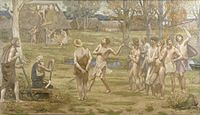
Pierre Puvis de Chavannes
Pierre Puvis de Chavannes (French pronunciation: [pjɛʁ pyvi də ʃavan]; 14 December 1824 – 24 October 1898) was a French painter known for his mural painting, who came to be known as "the painter for France".[1] He became the co-founder and president of the Société Nationale des Beaux-Arts, and his work influenced many other artists, notably Robert Genin, and he aided medallists by designs and suggestions for their works.[2] Puvis de Chavannes was a prominent painter in the early Third Republic. Émile Zola described his work as "an art made of reason, passion, and will".[3]
Pierre Puvis de Chavannes
24 October 1898 (aged 73)
Death and the Maiden, The Dream, The Poor Fisherman
Early life[edit]
Puvis de Chavannes was born Pierre-Cécile Puvis in a suburb of Lyon, France, on December 14, 1824. He was the son of a mining engineer and descended from an old noble family of Burgundy. He later added the ancestral "de Chavannes" to his name. Throughout his life, he spurned his Lyon origins, preferring to identify himself with the 'strong' blood of the Burgundians, where his father originated.[4]
Puvis de Chavannes was educated at the Amiens College and at the Lycée Henri IV in Paris. He intended to follow his father's profession until a serious illness compelled him to convalesce at Mâcon with his brother and sister-in-law in 1844 and 1845, which interrupted his studies. A journey to Italy opened his mind to fresh ideas, and on his return to Paris in 1846, he announced his intention to become a painter.
He studied first under Eugène Delacroix, but only very briefly, as Delacroix closed his studio shortly afterwards due to ill health. He studied subsequently under Henri Scheffer and then Thomas Couture.[5][6] His training was not classical as he found that he preferred to work alone. He took a large studio near the Gare de Lyon and attended anatomy classes at the Académie des Beaux Arts.[7] It was not until a number of years later, when the government of France acquired one of his works, that he gained wide recognition.
In 1850, Puvis de Chavannes made his Salon debut with Dead Christ, Jeune noir à l'épée (Black youth with a sword),[8] The Reading Lesson, and Portrait of a Man.
Personal life[edit]
In Montmartre, he had an affair with one of his models, Suzanne Valadon, who would become one of the leading artists of the day as well as the mother, teacher, and mentor of Maurice Utrillo. From 1856, he was in a relationship with the Romanian princess, Marie Cantacuzène. The couple were together for 40 years, and were married before their deaths in 1898.[14]
Beginning in 1926, The Prix Puvis de Chavannes (Puvis de Chavannes prize) was awarded by the National Society of Fine Arts (Société Nationale des Beaux-Arts). The Prix Puvis de Chavannes is the retrospective exhibition in Paris of the main works of the artist awarded the prize that year. During the twentieth century, this exhibition was located at the Grand Palais or the Musée d'Art Moderne. Recipients of the prize include:
![]() Media related to Pierre Puvis de Chavannes at Wikimedia Commons
Media related to Pierre Puvis de Chavannes at Wikimedia Commons








